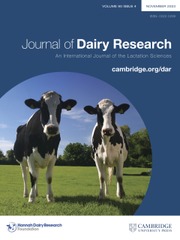No CrossRef data available.
Article contents
Long-term effects of early-life transition milk feeding on reproductive and lactation performance, and markers of oxidative status in Holstein heifers
Published online by Cambridge University Press: 17 November 2025
Summary
To determine the long-term effects of transition milk (TRANS), 30 female Holstein calves were allocated to two feeding groups (n = 15/group) after colostrum intake, receiving either 12 L of TRANS of their dam or 12 L of milk replacer (MR) per day. After 5 d of differential feeding, all calves received 12 L of MR/d. Until calving, heifers were weighed monthly. After calving, BW was recorded twice daily after milking. Body condition (BCS) and back fat thickness (BFT) were scored biweekly. Milk yield was recorded twice daily until d 200 in milk. Milk composition (protein, fat, and lactose), as well as somatic cell count (SCC) were analysed biweekly. Blood samples were taken 3 weeks before calving, at the day of calving and 3 weeks thereafter. Oxidative status was assessed as ferric reducing ability of plasma (FRAP) for antioxidative capacity, and as reactive oxygen metabolites via the dROM assay. Oxidative damage of lipids was measured via the thiobarbituric acid-reactive substances (TBARS) assay; peroxidized proteins were assessed using the advanced oxidation protein products (AOPP) assay. Performance until first insemination did not differ between the groups, as well as BW development until the first weeks of lactation. From week 7 of lactation onwards, TRANS had less BW than MR heifers but tended to have a higher BCS. Milk yield and composition did not differ between both treatments. Marker for oxidative stress showed typical patterns of increasing antioxidants before calving and increase in prooxidants after calving in both treatment groups. The results indicate that feeding TRANS in the first 5 days of life had no long-term effects on performance in the first lactation, except for lower postpartum BW in heifers fed TRANS than MR, under the current rearing and management conditions.
Information
- Type
- Research Article
- Information
- Copyright
- © The Author(s), 2025. Published by Cambridge University Press on behalf of Hannah Dairy Research Foundation.

